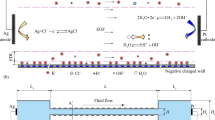Abstract
Numerical simulation using the finite differential method was carried out to analyze the diffusion of an impulse sample in the micro-channel driven by electroosmosis. The results show that the electrical field strength applied externally and the concentration of buffer solution play a significant role in the diffusion of sample, however, hydraulic diameter and aspect ratio of height to width of channel play a small role in it. Weakening the electrical field strength applied externally and the concentration of buffer solution properly can prevent the sample band from broadening effectively, and promote the efficiency of testing and separation as well as keep a faster speed of transport. The conclusions are helpful to the optimal design for micro-channel.
Similar content being viewed by others
References
Arulanandam S, Li D Q. Liquid transport in rectangular microchannels by electroosmotic pumping[J]. Colloids and Surfaces, A: Physicochemical and Engineering Aspects, 2000, 161(1):89–102.
Harrison D J, Fluri K, Seiler K. Micromachining a miniaturized capillary electrophoresis-based chemical analysis system on a chip[J]. Science, 1993, 261(5123):895–897.
Jacobson S C, Koutny J M, Hergenroeder R. Microchip capillary electrophoresis with an integrated postcolumn reactor[J]. Analytical Chemistry, 1994, 66(20):3472–3476.
Nie Deming, Lin Jianzhong, Shi Xing. One method to improve the uniformity of the flow field of electroosmosis[J]. Analytical Chemistry, 2004, 32(8):988–992 (in Chinese).
Wang Ruijin, Lin Jianzhong, Li Zhihua. Analysis of electro-osmotic flow characteristics at joint of capillaries with step change in ζ-potential and dimension[J]. International Forum on Biochip Technologies, 2004, 10:21–24.
Li Zhihua, Lin Jianzhong, Nie Deming. A new approach to minimize dispersion induced by turn in the capillary electrophoresis channel flows[J]. Applied Mathematics and Mechanics (English Edition), 2005, 26(6):685–690.
Taylor S G. Dispersion of soluble matter in solvent flowing slowly through a tube[J]. Proceedings of the Royal Society A, 1953, 219(2):186–193.
Aris R. On the dispersion of a solute in a fluid flowing through a tube[J]. Proceedings of the Royal Society A, 1956, 235(1):67–74.
Einstein A. Investigation on the Theory of the Brownian Movement[M]. Dover, New York 1956.
Mala G M, Li D Q, Werner C, et al. Flow characteristics of water through a microchannel between two parallel plates with electrokinetic effects[J]. International Journal of Heat and Fluid Flow, 1997, 18(5):485–496.
Author information
Authors and Affiliations
Corresponding author
Additional information
Contributed by LIN Jian-zhong
Project supported by the National Natural Science Foundation of China (No.20299030)
Rights and permissions
About this article
Cite this article
Zhang, K., Lin, Jz. & Li, Zh. Research on diffusion in micro-channel flow driven by electroosmosis. Appl Math Mech 27, 575–582 (2006). https://doi.org/10.1007/s10483-006-0502-1
Received:
Revised:
Issue Date:
DOI: https://doi.org/10.1007/s10483-006-0502-1




